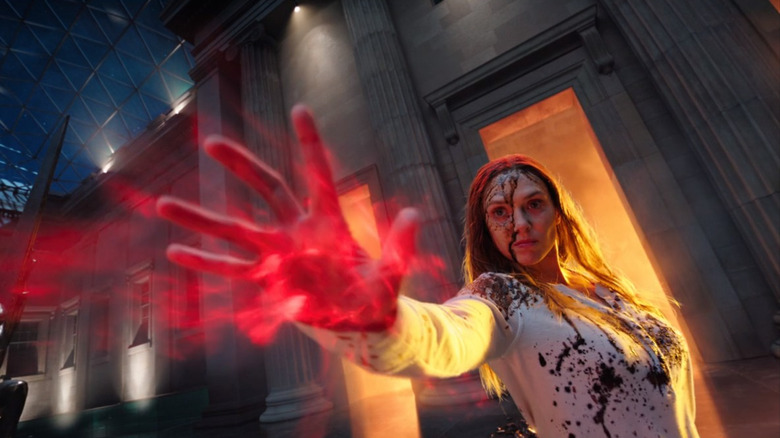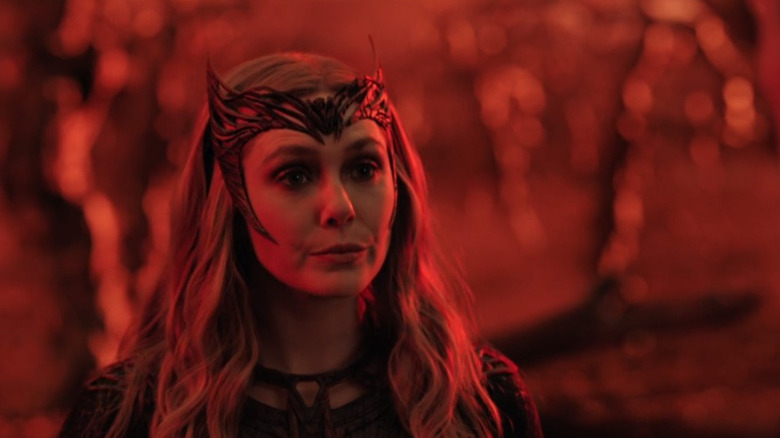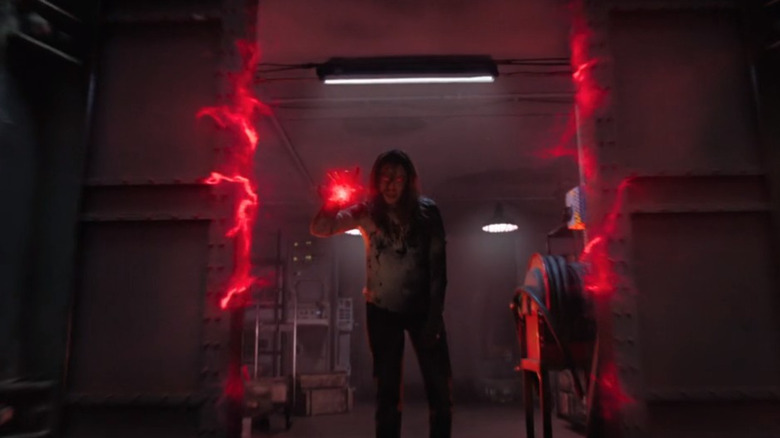An Early Version Of Doctor Strange In The Multiverse Of Madness Didn't Make Scarlet Witch A Villain Right Away
Michael Waldron, a writer on "Rick and Morty" and the screenwriter of "Doctor Strange in the Multiverse of Madness," said in an interview with /Film that assembling the script for the 28th MCU movie was akin to playing Frankenstein. He described sitting in a highly scrutinized writers' room — the scrutiny coming from the sheer size and high profile of the project — and the process of writing down many desired plot points, characters, and potential script ideas on a board. According to Waldron, there was a rudimentary version of the story already in place when he and director Sam Raimi joined the project. A Covid-related delay mercifully gave them the time they needed to start the story over from scratch and make the kind of movie they wanted.
In the documentary film "Assembled: The Making of Doctor Strange in the Multiverse of Madness" — currently available on Disney+ — Waldron talks about the early version of the story wherein the film's villain, the Scarlet Witch (Elizabeth Olsen), was going to retain her superhero status all the way until the end of the film. Then, in a twist, she was to reveal herself as willing to become a supervillain, flipping the switch from good to bad (which one can do in a comic book universe). Once a villain, the Scarlet Witch could then stand as the central antagonist in a future MCU installment.
Waldron's thinking, however, was that he didn't want to wait to see the Scarlet Witch as the villain in another movie. He didn't want to rob himself of the opportunity to make her a villain right now. As such, Wanda, through his re-working, became the villain right from the jump.
The Scarlet Witch is now the villain
Prior to the events of "Doctor Strange in the Multiverse of Madness," the Scarlet Witch — smarting from the death of her robot lover Vision (Paul Bettany) — had just reality-bent and mind-warped an entire small town into looking like a series of placid American TV sitcoms. The results and fallout of her warpage were detailed in the TV series "WandaVision." At some point between that series and "Multiverse," however, the Scarlet Witch ran across the Darkhold, a forbidden, Satanic-like spell book of immense evil. Reading the book corrupted the Scarlet Witch, and she became perfectly willing to kill others and sacrifice lives in order to re-create her sitcom life for real. You know she's evil because of her heavy eyeshadow.
In "Assembled," Olsen admits to being taken aback by the sudden decision to have her character suddenly play a villain ... and a scary villain at that. She also admits, however, that playing supervillains is just plain fun, saying that ultimate power would indeed erase one's traditional sense of ethics. So she was able to roll with it.
Waldron also pointed out that making Wanda a villain even made sense. In the events of "Avengers: Infinity War," she deliberately killed Vision in order to prevent the genocidal monster Thanos from stealing a vital component of Vision's robotic makeup: a magical gem. Her murder was undone by Thanos' newfound ability to rewind time, however, and her murder was for naught; Vision was killed by Thanos anyway. Maybe only one death from Vision's perspective, but Wanda seems to have recalled both. Thanos' time abilities were, earlier, given him by Dr. Strange. One can see how the trauma of the event, facilitated by Doctor Strange, would cause her to snap.
The COVID-19 delay
Waldron talks a little bit more about his process in "Assembled," recalling the panic he felt when he was brought in. Sets, he says, were already being built when he was asked to start writing the script for "Multiverse," given only three weeks to complete it. It was in the third week — March of 2020 — that the COVID-19 lockdowns began. The ensuing production delay from May to November gave them leeway to trash the entire first version. Waldron hasn't gone into too much detail as to what else was in that version other than Wanda's late-stage change of heart. He just claims that the new version was "better and much more exciting."
While parallel universes are old hat in science fiction and fantasy stories — anyone who has seen Spock's beard is already pretty familiar with the concept — the notion is relatively new to the MCU. It's a notion about which we know surprisingly a lot, even if Doctor Strange knows surprisingly little. Parallel universes had been utilized in "Loki" and in "Spider-Man: No Way Home," and now "Multiverse of Madness." Given the facile cameos in "Multiverse," and Raimi's clear interest in zombie mayhem over sprawling interdimensional antics, one might be able to postulate that he and Waldron's "more interesting" version was more to do with their interest in horror than with superheroes.
Whatever the result, one can say that the horror elements of "Multiverse" are the parts that stand the strongest.


